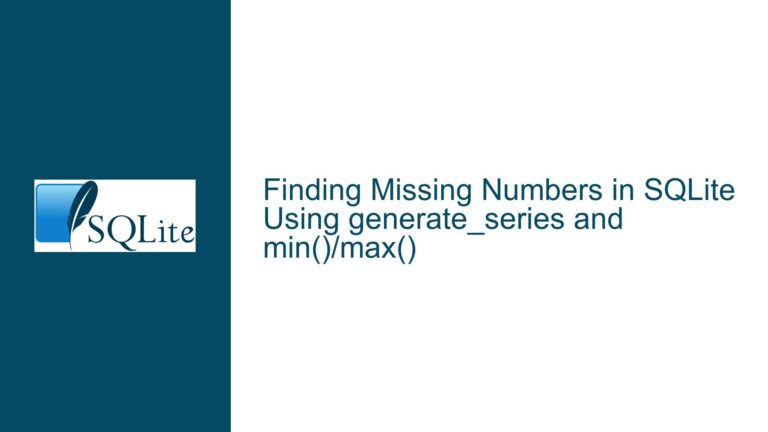Assertion Failure in sqlite3VdbeExec Due to SQLITE_ENABLE_CURSOR_HINTS
Understanding the Assertion Failure in sqlite3VdbeExec
The core issue revolves around an assertion failure in the sqlite3VdbeExec function, which is a critical part of SQLite’s virtual machine responsible for executing bytecode generated from SQL statements. The failure occurs when executing a specific sequence of SQL queries involving table creation, view creation, and a complex SELECT statement with a LEFT JOIN and GROUP BY clause. The assertion failure specifically points to a condition where a cursor (pC) is expected to be non-null, but the assertion pC!=0 fails, indicating that the cursor is unexpectedly null.
The problematic query sequence is as follows:
CREATE TABLE v0 (c1 UNIQUE, c0);
INSERT INTO v0 (c0) VALUES (0);
CREATE VIEW v1 AS SELECT c1 COLLATE NOCASE FROM v0;
SELECT 0 FROM v0 LEFT JOIN v1 GROUP BY 1 HAVING (SELECT 0 FROM v0 LEFT JOIN v0 ON v1.c1);
The error manifests as:
sqlite3: sqlite3.c:93391: sqlite3VdbeExec: Assertion `pC!=0' failed.
[1] 1895903 abort ./sqlite3 < poc
This error is particularly interesting because it only occurs under specific conditions, such as when certain SQLite optimizations are enabled. Specifically, the issue is tied to the SQLITE_ENABLE_CURSOR_HINTS compile-time option, which is not intended for general use but rather for specialized systems like COMDB2. When this option is enabled, it introduces an edge case that leads to the assertion failure.
Root Causes of the Assertion Failure
The assertion failure in sqlite3VdbeExec is primarily caused by the interaction between the SQLITE_ENABLE_CURSOR_HINTS compile-time option and the specific query structure. Here are the key factors contributing to the issue:
SQLITE_ENABLE_CURSOR_HINTS Compile-Time Option: This option is designed to provide additional cursor-related hints to the query planner, primarily for use in COMDB2, a distributed database system built on SQLite. When enabled, it modifies the behavior of cursor management in SQLite’s virtual machine. However, this option is not intended for general use and can introduce unexpected behavior in standard SQLite builds.
Complex Query Structure: The query sequence involves creating a table (
v0), inserting data, creating a view (v1), and then executing aSELECTstatement with aLEFT JOINandGROUP BYclause. TheHAVINGclause further complicates the query by including a subquery that references the same table (v0) and the view (v1). This complexity triggers an edge case in the query planner whenSQLITE_ENABLE_CURSOR_HINTSis enabled.Optimization Interaction: The issue is exacerbated by the presence of other optimizations, such as
SQLITE_CoverIdxScan. When these optimizations are enabled, they interact withSQLITE_ENABLE_CURSOR_HINTSin a way that leads to the assertion failure. DisablingSQLITE_CoverIdxScanmitigates the issue, but this is not a proper fix.Cursor Management Bug: The root cause of the assertion failure is a bug in cursor management within the
sqlite3VdbeExecfunction. WhenSQLITE_ENABLE_CURSOR_HINTSis enabled, the function fails to properly initialize or validate a cursor (pC), leading to the null pointer assertion failure.
Resolving the Assertion Failure: Steps and Solutions
To address the assertion failure in sqlite3VdbeExec, follow these detailed troubleshooting steps and solutions:
1. Disable SQLITE_ENABLE_CURSOR_HINTS
Since the issue is directly tied to the SQLITE_ENABLE_CURSOR_HINTS compile-time option, the simplest and most effective solution is to disable this option unless you are specifically using SQLite as part of COMDB2. This option is not intended for general use and provides no benefit in standard SQLite builds. To disable it, remove -DSQLITE_ENABLE_CURSOR_HINTS from your compilation flags.
Example compilation flags:
export CFLAGS="-g -O0 -DSQLITE_DEBUG
-DSQLITE_ENABLE_TREETRACE
-DSQLITE_ENABLE_WHERETRACE
-DSQLITE_COUNTOFVIEW_OPTIMIZATION
-DSQLITE_ENABLE_STAT4"
2. Update to the Latest SQLite Version
The issue has been fixed in the SQLite source code. The fix was implemented in commit 4c5a3c5fb351cc1c. If you are using an older version of SQLite, update to the latest version to ensure the fix is included. You can download the latest source code from the SQLite website or update your repository if you are building from source.
3. Review and Simplify Complex Queries
While the issue is primarily caused by the SQLITE_ENABLE_CURSOR_HINTS option, complex queries like the one in the example can expose edge cases in the query planner. Review your queries for unnecessary complexity and consider simplifying them. For example, the HAVING clause in the problematic query includes a subquery that references the same table and view, which may not be necessary. Rewriting the query to avoid such self-references can help prevent similar issues.
Example of a simplified query:
SELECT 0 FROM v0 LEFT JOIN v1 GROUP BY 1;
4. Test with Different Optimization Settings
If you cannot immediately update SQLite or disable SQLITE_ENABLE_CURSOR_HINTS, you can test your queries with different optimization settings to identify which optimizations are contributing to the issue. Use the .testctrl optimizations command to selectively enable or disable optimizations.
Example:
.testctrl optimizations 0x00000020; -- Disable SQLITE_CoverIdxScan
This approach is not a permanent solution but can help you isolate the problem and work around it temporarily.
5. Enable Debugging and Tracing
To gain more insight into the issue, enable SQLite’s debugging and tracing features. The SQLITE_DEBUG, SQLITE_ENABLE_TREETRACE, and SQLITE_ENABLE_WHERETRACE options provide detailed information about query planning and execution. This can help you identify the exact point at which the assertion failure occurs and understand the state of the virtual machine at that time.
Example compilation flags with debugging enabled:
export CFLAGS="-g -O0 -DSQLITE_DEBUG
-DSQLITE_ENABLE_TREETRACE
-DSQLITE_ENABLE_WHERETRACE
-DSQLITE_COUNTOFVIEW_OPTIMIZATION
-DSQLITE_ENABLE_STAT4"
6. Report Issues to the SQLite Team
If you encounter similar issues even after applying the above steps, consider reporting them to the SQLite development team. Provide detailed information, including the SQL queries, compilation flags, and error messages. The SQLite team is highly responsive and can provide further assistance or implement additional fixes if necessary.
You can report issues via the SQLite Forum or the SQLite Bug Tracker.
By following these steps, you can effectively resolve the assertion failure in sqlite3VdbeExec and ensure stable and reliable operation of your SQLite database. Always remember to use compile-time options judiciously and keep your SQLite installation up to date to benefit from the latest fixes and improvements.






